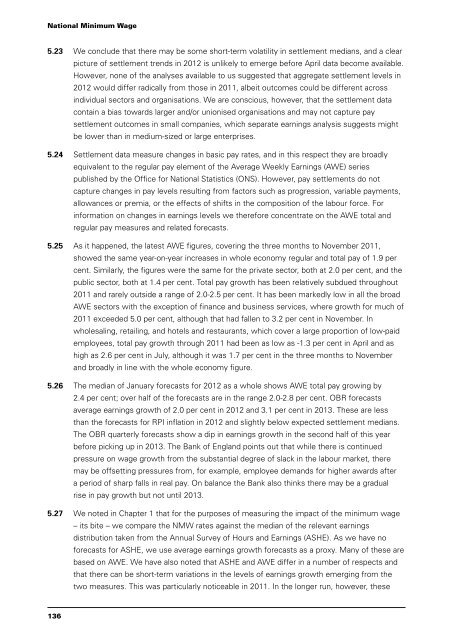National Minimum Wage
National Minimum Wage
National Minimum Wage
You also want an ePaper? Increase the reach of your titles
YUMPU automatically turns print PDFs into web optimized ePapers that Google loves.
<strong>National</strong> <strong>Minimum</strong> <strong>Wage</strong><br />
5.23 We conclude that there may be some short-term volatility in settlement medians, and a clear<br />
picture of settlement trends in 2012 is unlikely to emerge before April data become available.<br />
However, none of the analyses available to us suggested that aggregate settlement levels in<br />
2012 would differ radically from those in 2011, albeit outcomes could be different across<br />
individual sectors and organisations. We are conscious, however, that the settlement data<br />
contain a bias towards larger and/or unionised organisations and may not capture pay<br />
settlement outcomes in small companies, which separate earnings analysis suggests might<br />
be lower than in medium-sized or large enterprises.<br />
5.24 Settlement data measure changes in basic pay rates, and in this respect they are broadly<br />
equivalent to the regular pay element of the Average Weekly Earnings (AWE) series<br />
published by the Office for <strong>National</strong> Statistics (ONS). However, pay settlements do not<br />
capture changes in pay levels resulting from factors such as progression, variable payments,<br />
allowances or premia, or the effects of shifts in the composition of the labour force. For<br />
information on changes in earnings levels we therefore concentrate on the AWE total and<br />
regular pay measures and related forecasts.<br />
5.25 As it happened, the latest AWE figures, covering the three months to November 2011,<br />
showed the same year-on-year increases in whole economy regular and total pay of 1.9 per<br />
cent. Similarly, the figures were the same for the private sector, both at 2.0 per cent, and the<br />
public sector, both at 1.4 per cent. Total pay growth has been relatively subdued throughout<br />
2011 and rarely outside a range of 2.0-2.5 per cent. It has been markedly low in all the broad<br />
AWE sectors with the exception of finance and business services, where growth for much of<br />
2011 exceeded 5.0 per cent, although that had fallen to 3.2 per cent in November. In<br />
wholesaling, retailing, and hotels and restaurants, which cover a large proportion of low-paid<br />
employees, total pay growth through 2011 had been as low as -1.3 per cent in April and as<br />
high as 2.6 per cent in July, although it was 1.7 per cent in the three months to November<br />
and broadly in line with the whole economy figure.<br />
5.26 The median of January forecasts for 2012 as a whole shows AWE total pay growing by<br />
2.4 per cent; over half of the forecasts are in the range 2.0-2.8 per cent. OBR forecasts<br />
average earnings growth of 2.0 per cent in 2012 and 3.1 per cent in 2013. These are less<br />
than the forecasts for RPI inflation in 2012 and slightly below expected settlement medians.<br />
The OBR quarterly forecasts show a dip in earnings growth in the second half of this year<br />
before picking up in 2013. The Bank of England points out that while there is continued<br />
pressure on wage growth from the substantial degree of slack in the labour market, there<br />
may be offsetting pressures from, for example, employee demands for higher awards after<br />
a period of sharp falls in real pay. On balance the Bank also thinks there may be a gradual<br />
rise in pay growth but not until 2013.<br />
5.27 We noted in Chapter 1 that for the purposes of measuring the impact of the minimum wage<br />
– its bite – we compare the NMW rates against the median of the relevant earnings<br />
distribution taken from the Annual Survey of Hours and Earnings (ASHE). As we have no<br />
forecasts for ASHE, we use average earnings growth forecasts as a proxy. Many of these are<br />
based on AWE. We have also noted that ASHE and AWE differ in a number of respects and<br />
that there can be short-term variations in the levels of earnings growth emerging from the<br />
two measures. This was particularly noticeable in 2011. In the longer run, however, these<br />
136


